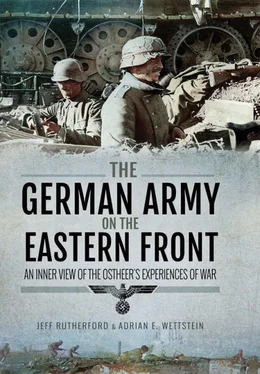In the reporting period, the two medic companies carried out 38 blood transfusions. The donors were members of the companies.
During the campaign against Russia, the medic units have 6 fallen and 24 wounded in their own ranks.
The numbers cited above include only men treated by the medical units – neither dead nor missing soldiers were included. But wounded men alone counted for 30 per cent of the divisional personnel for the first two months of the invasion of the Soviet Union. Many of the wounded men, as well as most of the sick, returned sooner or later to their units.
While sick soldiers were already a problem during the summer, the German army had to adjust to a completely new situation when the campaign against the Soviet Union dragged on into winter. Not only were winter clothes such as quilted jackets, gloves and earmuffs arriving slowly and in completely insufficient numbers, but the troops were physically exhausted by the nearly permanent advance since 22 June 1941. All of this is reflected in the following source, sent by the 123rd Infantry Division to its superior army corps in November 1941: [33]
The division’s state of health has continually deteriorated lately. This fact is not so much revealed through a massive occurrence of severe illnesses, although serious colds have increasingly arisen in this form. What is noticeable in comparison is the severe deterioration of the troops’ general state of strength. In this way, the resistance of the individual man is considerably reduced. This makes itself noticeable above all in an abnormally severe susceptibility, which, as already stated, manifests itself not so much in serious life-threatening illnesses, but rather much more in the relatively high percentage, especially in the infantry regiments, that has arisen of minor illnesses of the respiratory organs, rheumatic illnesses, as well as pictures of general exhaustion.
The current deployment does not allow for these illnesses to be treated properly, thus an unacceptable percentage of the troops will fall out. On the other hand, productivity is considerably reduced as a result. This state of exhaustion frequently leads individual men to an excessive apathy that is accompanied with a reduction of the defensive will against sickness, which under current circumstances must lead to a further worsening of the general state of health.
With this comes the danger that it will be accompanied by a severely increasing lice infestation. […]
In this way, a sharply growing number of skin diseases have lately occurred. To be sure, these constitute no serious threat. In contrast, an outbreak of typhus would be very alarming. The severe lice infestation would facilitate a fast spreading of the disease, and at the same time, the generally poor state of strength of the troops must lead to a very unfavourable influence on the course of the disease.
A further worsening of these conditions thus can only be avoided when the troops are given the opportunity for some time in a quiet position to take the necessary measures for the restoration of reasonable health conditions.
Parallel with an improvement in the state of strength, the radical treatment of lesser illnesses as well as a true de-lousing on a grand scale would substantially improve the combat strength.
This source is especially striking since it points to a deteriorating health situation that was predicted to become severe in a few weeks, at a time when the Army Chief of Staff Franz Halder and the Army Groups and Armies’ Chiefs of Staff met in Orsha to discuss the further course of war. They agreed there – with few reservations – to undertake a last push on Moscow in the hope of ending the war in the east. But it was clear that an operation with troops as described in the report of the 123rd Infantry Division was doomed from the beginning. Worse, it would have severe consequences when the German offensive was continued beyond its culmination point.
Rest and time for personal hygiene was urgently needed, but the demands of the rapid advance and the lack of manpower frequently did not allow for such things. As a consequence, troops were full of lice, and the German military leadership feared the diseases spread by lice, such as typhus fever. The lack of hygiene also promoted dysentery. While these hygiene issues were especially concerning for frontline troops, they were also an issue for those in the rear.
A major problem for the Wehrmacht in handling disease was the interaction of soldiers with the Soviet civilian population. The remaining civilian population was often prone to illnesses due to a lack of food, as well as the presence of numerous children and elderly people. While a complete separation of the two groups was simply not possible, the German army had to divert some of its overstrained medical resources in hopes of at least controlling the civilian population and containing the outbreaks of serious diseases before they could spread to the military units – of course an issue primarily caused by harsh German occupation policy. Termed the ‘regulation of the [population’s] health’, this issue became more and more pressing for units in the east, especially those engaged in positional warfare who remained in specific sectors for longer periods of time. The following source is such an example from the 87th Infantry Division, holding a section of the front sector in the Velizh area in Army Group Centre’s northern sector. The order was issued by the IVb, the divisional doctor: [34]
The regulation of the health of the population that is contaminated by typhus, typhoid fever, [and] dysentery is of essential importance for the protection of the troops against epidemics.
The combating of infectious diseases [and] lice within the troops and civil population, the stopping of the civil population’s wandering and a complete separation of housing are hereby urgent.
For the implementation I order:
1) In every station district a station district medical officer is appointed (appendix). He is the adviser of the station district or station commander for all questions and measures of the regulation of health. The instructions given by him on behalf of the station district commander are to be implemented promptly by the town commanders.
2) An epidemic troop is to be established with every station district medical officer (for composition and detachment see appendix), which is to be used for the continuous control of his area and the execution of his measures.
3) By headquarters’ order, the reporting of every case and suspicion of infectious diseases is made a duty for a) the troops, b) Russian doctors on hand, c) mayors and the population.
4) The station commanders arrange that one accessible sauna and one delousing chamber next to it are available for the civil population of their areas and are used frequently. Pay attention to the construction of proper, sufficient civilian latrines and their use.
The town commander regulates provisions for ill civilians by decree to the mayor.
The German army’s medical services and medical staff were generally effective in preventing dangerous diseases from becoming epidemics. But the increase in pressure on German troops, especially when the combat situation become more and more unfavourable from the summer of 1943 on, had a very negative effect on the health situation of German soldiers, especially those in the front line. Military necessity frequently clashed with health considerations, and the former generally won out. The following report by 306th Infantry Division, then fighting in the Nikopol sector, gives an insight in this dilemma: [35]
After consultation with the divisional doctor, I report on the state of health of the fighting troops:
a) all cases of non-transmissible diseases will remain with the troops.
Читать дальше






![John Stieber - Against the Odds - Survival on the Russian Front 1944-1945 [2nd Edition]](/books/405234/john-stieber-against-the-odds-survival-on-the-russian-front-1944-1945-2nd-edition-thumb.webp)





